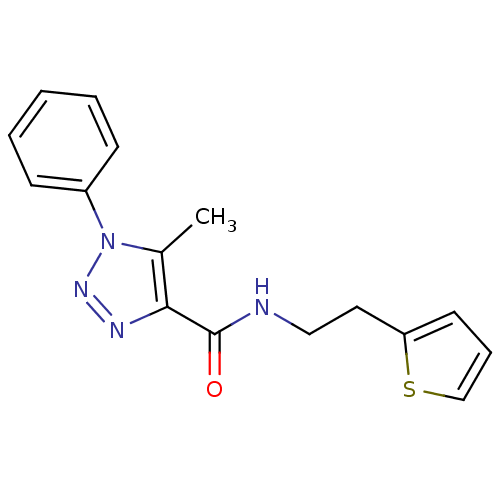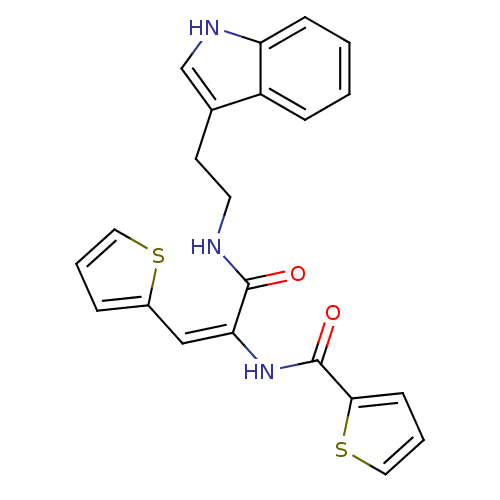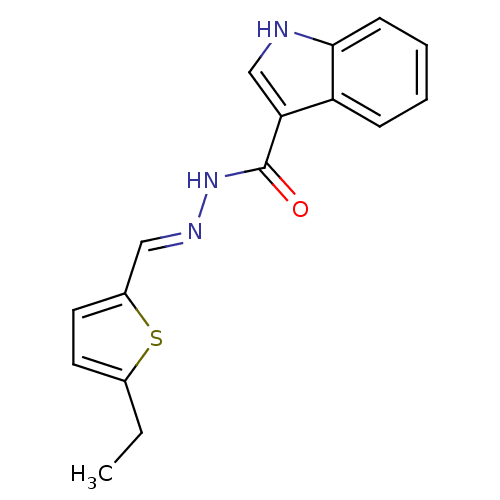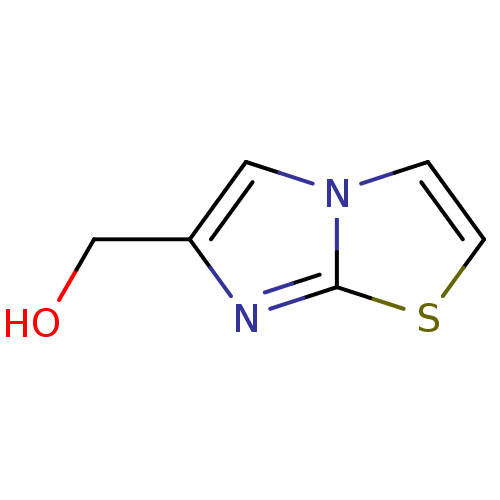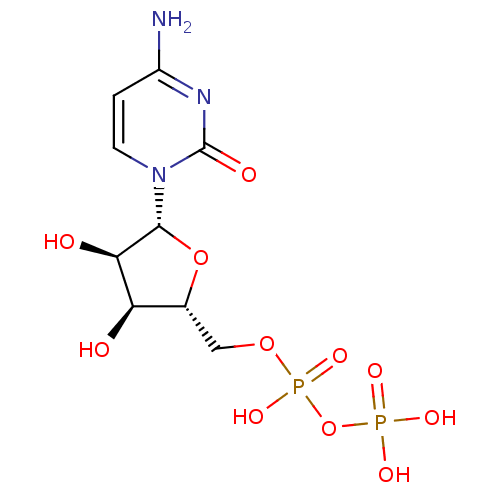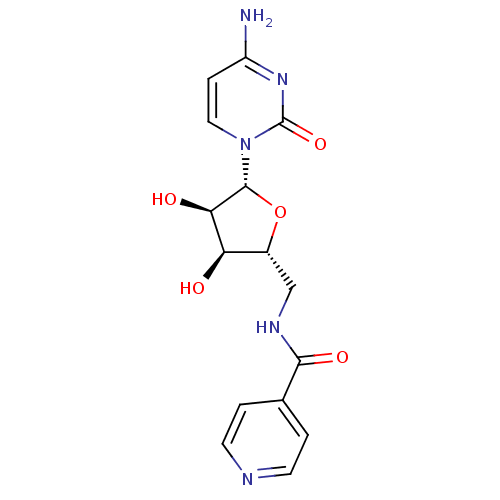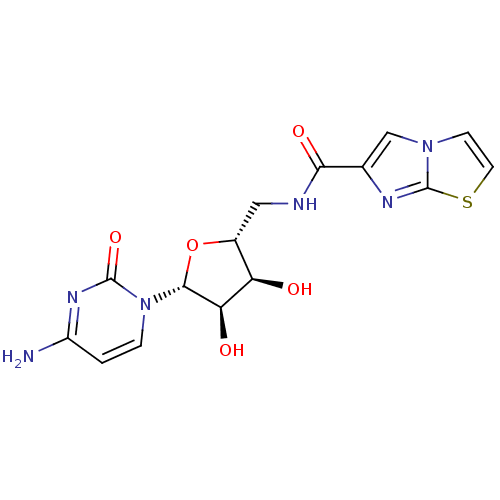Affinity DataIC50: 900nMpH: 7.5 T: 2°CAssay Description:A tritium release assay was used to determin the in vitro inhibitory strengths of various compounds. The inhibitory potency of human TS was determin...More data for this Ligand-Target Pair
Affinity DataIC50: 3.00E+4nM Kd: 5.00E+3nMpH: 7.5 T: 2°CAssay Description:A tritium release assay was used to determin the in vitro inhibitory strengths of various compounds. The inhibitory potency of human TS was determin...More data for this Ligand-Target Pair
Affinity DataIC50: 7.00E+4nM Kd: 2.00E+3nMpH: 7.5 T: 2°CAssay Description:A tritium release assay was used to determin the in vitro inhibitory strengths of various compounds. The inhibitory potency of human TS was determin...More data for this Ligand-Target Pair
Affinity DataIC50: 7.00E+4nM Kd: 1.00E+3nMpH: 7.5 T: 2°CAssay Description:A tritium release assay was used to determin the in vitro inhibitory strengths of various compounds. The inhibitory potency of human TS was determin...More data for this Ligand-Target Pair
Affinity DataIC50: 1.15E+5nMpH: 7.5 T: 2°CAssay Description:A tritium release assay was used to determin the in vitro inhibitory strengths of various compounds. The inhibitory potency of human TS was determin...More data for this Ligand-Target Pair
Affinity DataIC50: 1.15E+5nMpH: 7.5 T: 2°CAssay Description:A tritium release assay was used to determin the in vitro inhibitory strengths of various compounds. The inhibitory potency of human TS was determin...More data for this Ligand-Target Pair
Affinity DataIC50: 1.40E+5nMpH: 7.5 T: 2°CAssay Description:A tritium release assay was used to determin the in vitro inhibitory strengths of various compounds. The inhibitory potency of human TS was determin...More data for this Ligand-Target Pair
Affinity DataIC50: 1.60E+5nMpH: 7.5 T: 2°CAssay Description:A tritium release assay was used to determin the in vitro inhibitory strengths of various compounds. The inhibitory potency of human TS was determin...More data for this Ligand-Target Pair
Affinity DataIC50: 1.60E+5nMpH: 7.5 T: 2°CAssay Description:A tritium release assay was used to determin the in vitro inhibitory strengths of various compounds. The inhibitory potency of human TS was determin...More data for this Ligand-Target Pair
Affinity DataIC50: 2.40E+5nMpH: 7.5 T: 2°CAssay Description:A tritium release assay was used to determin the in vitro inhibitory strengths of various compounds. The inhibitory potency of human TS was determin...More data for this Ligand-Target Pair
Affinity DataIC50: 2.60E+5nMpH: 7.5 T: 2°CAssay Description:A tritium release assay was used to determin the in vitro inhibitory strengths of various compounds. The inhibitory potency of human TS was determin...More data for this Ligand-Target Pair
Affinity DataIC50: >5.00E+5nMpH: 7.5 T: 2°CAssay Description:A tritium release assay was used to determin the in vitro inhibitory strengths of various compounds. The inhibitory potency of human TS was determin...More data for this Ligand-Target Pair
Affinity DataIC50: >5.00E+5nMpH: 7.5 T: 2°CAssay Description:A tritium release assay was used to determin the in vitro inhibitory strengths of various compounds. The inhibitory potency of human TS was determin...More data for this Ligand-Target Pair
Affinity DataIC50: >5.00E+5nMpH: 7.5 T: 2°CAssay Description:A tritium release assay was used to determin the in vitro inhibitory strengths of various compounds. The inhibitory potency of human TS was determin...More data for this Ligand-Target Pair
Target2-C-methyl-D-erythritol 2,4-cyclodiphosphate synthase(Burkholderia pseudomallei (strain K96243))
Northern Illinois University
Curated by ChEMBL
Northern Illinois University
Curated by ChEMBL
Affinity DataKd: 1.35E+5nMAssay Description:Binding affinity to Burkolderia pseudomallei IspF by surface plasmon resonance methodMore data for this Ligand-Target Pair
Target2-C-methyl-D-erythritol 2,4-cyclodiphosphate synthase(Burkholderia pseudomallei (strain K96243))
Northern Illinois University
Curated by ChEMBL
Northern Illinois University
Curated by ChEMBL
Affinity DataKd: 9.00E+4nMAssay Description:Binding affinity to Burkolderia pseudomallei IspF by surface plasmon resonance methodMore data for this Ligand-Target Pair
Target2-C-methyl-D-erythritol 2,4-cyclodiphosphate synthase(Burkholderia pseudomallei (strain K96243))
Northern Illinois University
Curated by ChEMBL
Northern Illinois University
Curated by ChEMBL
Affinity DataKd: 7.50E+4nMAssay Description:Binding affinity to Burkolderia pseudomallei IspF by surface plasmon resonance methodMore data for this Ligand-Target Pair
Target2-C-methyl-D-erythritol 2,4-cyclodiphosphate synthase(Burkholderia pseudomallei (strain K96243))
Northern Illinois University
Curated by ChEMBL
Northern Illinois University
Curated by ChEMBL
Affinity DataKd: 1.80E+5nMAssay Description:Binding affinity to Burkolderia pseudomallei IspF by surface plasmon resonance methodMore data for this Ligand-Target Pair
Target2-C-methyl-D-erythritol 2,4-cyclodiphosphate synthase(Burkholderia pseudomallei (strain K96243))
Northern Illinois University
Curated by ChEMBL
Northern Illinois University
Curated by ChEMBL
Affinity DataKd: 7.00E+4nMAssay Description:Binding affinity to Burkolderia pseudomallei IspF by surface plasmon resonance methodMore data for this Ligand-Target Pair
Target2-C-methyl-D-erythritol 2,4-cyclodiphosphate synthase(Burkholderia pseudomallei (strain K96243))
Northern Illinois University
Curated by ChEMBL
Northern Illinois University
Curated by ChEMBL
Affinity DataKd: 2.00E+5nMAssay Description:Binding affinity to Burkolderia pseudomallei IspF by surface plasmon resonance methodMore data for this Ligand-Target Pair
Target2-C-methyl-D-erythritol 2,4-cyclodiphosphate synthase(Burkholderia pseudomallei (strain K96243))
Northern Illinois University
Curated by ChEMBL
Northern Illinois University
Curated by ChEMBL
Affinity DataKd: 1.48E+5nMAssay Description:Binding affinity to Burkolderia pseudomallei IspF by surface plasmon resonance methodMore data for this Ligand-Target Pair

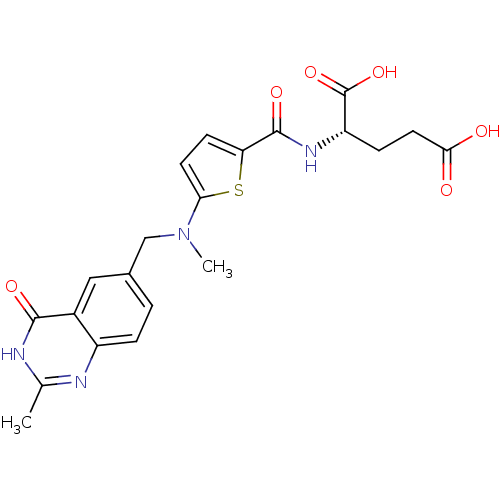
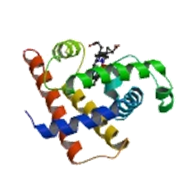 3D Structure (crystal)
3D Structure (crystal)